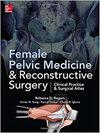阴道和腹腔镜网状子宫切除术治疗子宫阴道脱垂的长期疗效:一项平行队列研究(eVAULT)
IF 1.4
4区 医学
Q3 OBSTETRICS & GYNECOLOGY
Female Pelvic Medicine and Reconstructive Surgery
Pub Date : 2022-04-24
DOI:10.1097/SPV.0000000000001188
引用次数: 0
摘要
重要性:关于长期补片子宫切除术结果的数据有限。本研究提供了原始VAULT(阴道和腹腔镜网状子宫切除术治疗子宫阴道脱垂试验)研究的7年数据。目的本研究的目的是比较腹腔镜骶骨子宫切除术(LSHP)和阴道网状子宫切除术(VMHP)的长期疗效和成功率。这项多中心、前瞻性平行队列研究是最初VAULT研究的延伸。联系受试者,并取得知情同意。我们收集了基线人口统计数据和最新的盆腔器官脱垂量化检查数据,并进行了电话访谈,以更新人口统计信息,收集盆底窘迫调查表、患者总体改善印象、脱垂再手术/必要使用和并发症。手术成功的定义为无隆起症状,满意度评分为“非常好”或“好得多”,无再次手术/必要的使用。结果8个原始站点中有5个纳入了53名受试者(LSHP n = 34, VMHP n = 19)。LSHP组更年轻(67 vs 74, P < 0.01),但在胎次、体重指数、绝经期、种族、保险、吸烟或Charlson共病指数方面没有差异。主观随访时间中位数为7.3±0.9年。综合成功率为82% LSHP和74% VMHP。盆底窘迫量表短表综合评分在基线时相似,两组均有改善(P < 0.01), LSHP组较低(20.8比43.8,P = 0.01)。并发症发生率无差异。结论术后7年内,LSHP和VMHP的成功率高,再治疗率低,并发症发生率低,组间无差异。虽然LSHP组有更好的解剖学支持的趋势,但这些发现并不显著,我们没有足够的能力来检测差异。本文章由计算机程序翻译,如有差异,请以英文原文为准。
Long-Term Outcomes After Vaginal and Laparoscopic Mesh Hysteropexy for Uterovaginal Prolapse: A Parallel Cohort Study (eVAULT)
Importance Data on long-term mesh hysteropexy outcomes are limited. This study provides 7-year data from the original VAULT (Vaginal and Laparoscopic Mesh Hysteropexy for Uterovaginal Prolapse Trial) study. Objective The aim of this study was to compare long-term outcomes and success for laparoscopic sacral hysteropexy (LSHP) and vaginal mesh hysteropexy (VMHP). Study Design This multicenter, prospective parallel cohort was an extension to the initial VAULT study. Subjects were contacted, and informed consent was obtained. We collected baseline demographics and the latest Pelvic Organ Prolapse–Quantification examination data from chart review and conducted telephone interviews to update demographic information and collect Pelvic Floor Distress Inventory Short-Form, Patient Global Impression of Improvement, prolapse reoperation/pessary use, and complications. Surgical success was defined as no bulge symptoms, satisfaction score of “very much better” or “much better,” and no reoperation/pessary use. Results Five of 8 original sites enrolled 53 subjects (LSHP n = 34 and VMHP n = 19). The LSHP group was younger (67 vs 74, P < 0.01), but there were no differences in parity, body mass index, menopause, race, insurance, tobacco use, or Charlson Comorbidity Index. The median subjective follow-up was 7.3 ± 0.9 years. Composite success was 82% LSHP versus 74% VMHP. Pelvic Floor Distress Inventory Short-Form composite scores were similar at baseline and improved for both groups (P < 0.01) with lower bother observed in the LSHP group (20.8 vs 43.8, P = 0.01). There were no differences in complications. Conclusions Over 7 years after surgery, LSHP and VMHP have high success, low retreatment, and low complication rates that did not differ between groups. Although there is a trend toward better anatomic support in the LSHP group, these findings were not significant and we are underpowered to detect a difference.
求助全文
通过发布文献求助,成功后即可免费获取论文全文。
去求助
来源期刊

Female Pelvic Medicine and Reconstructive Surgery
OBSTETRICS & GYNECOLOGY-
CiteScore
2.10
自引率
12.50%
发文量
228
期刊介绍:
Female Pelvic Medicine & Reconstructive Surgery, official journal of the American Urogynecologic Society, is a peer-reviewed, multidisciplinary journal dedicated to specialists, physicians and allied health professionals concerned with prevention, diagnosis and treatment of female pelvic floor disorders. The journal publishes original clinical research, basic science research, education, scientific advances, case reports, scientific reviews, editorials and letters to the editor.
 求助内容:
求助内容: 应助结果提醒方式:
应助结果提醒方式:


